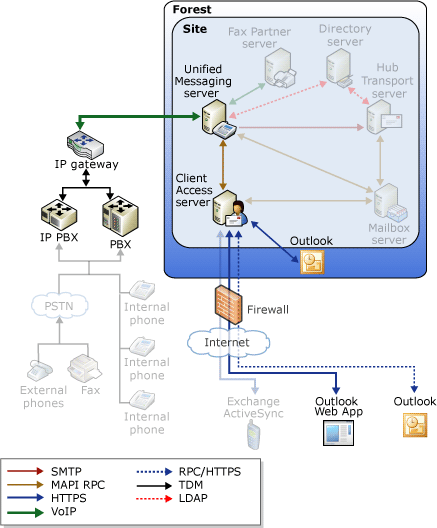Applies to: Exchange Server 2010 SP3, Exchange Server 2010 SP2
Topic Last Modified: 2011-04-28
Incoming calls placed by users using the Play on Phone feature are received and routed by a Microsoft Exchange Server 2010 Unified Messaging server.
Play on Phone
The Exchange 2010 Unified Messaging Play on Phone feature enables UM-enabled users to access a voice mail message. However, instead of playing the media file over their computer speakers, they can listen to the message on a telephone.
When UM-enabled users work in office cubicles, use a public computer, have a computer that isn't enabled for multimedia, or have a voice message that's confidential, they may not want to or may be unable to play a voice message over their computer speakers. The Play on Phone feature lets UM-enabled users play the voice message over a telephone. The Play on Phone feature is available in Exchange 2010 Outlook Web App and in Microsoft Office Outlook 2007.
The following figure illustrates how Exchange 2010 Unified Messaging routes the incoming calls for UM-enabled users who use the Play on Phone feature.

The Unified Messaging Web services are installed on Client Access server. Unified Messaging Web services enable Session Initiation Protocol (SIP) functionality on a Client Access server. This functionality enables a user to record a voice mail greeting or use the Play on Phone feature. The Unified Messaging server uses only SIP to communicate. Therefore, the UM Web service is installed on a computer running the Client Access server role and is required to enable the Client Access server to communicate with the Unified Messaging server.
 Important: Important: |
|---|
| By default, SIP data, which includes Unified Messaging server settings and other call information sent from a Unified Messaging server to a Client Access server, isn't encrypted. This could pose a security threat. To help protect all SIP traffic, use Transport Layer Security (TLS) to encrypt the traffic between a Client Access server and a Unified Messaging server by configuring TLS security settings on the UM dial plan. For more information about SIP security and TLS, see Understanding Unified Messaging VoIP Security. |

